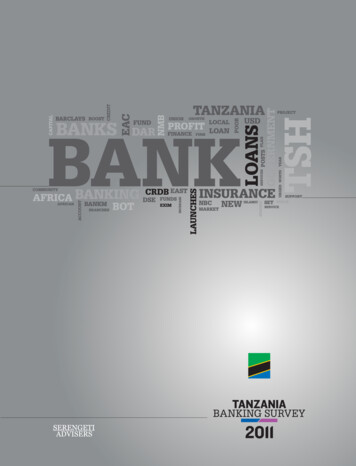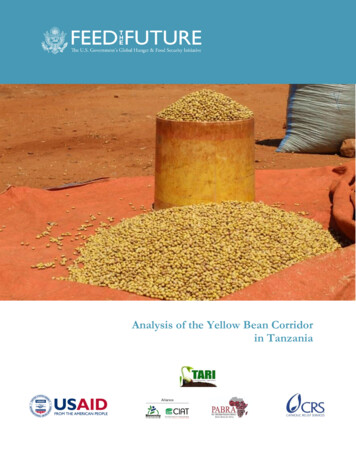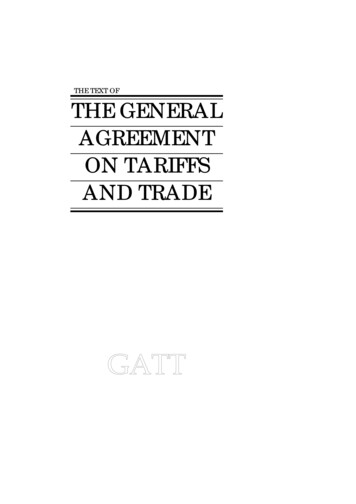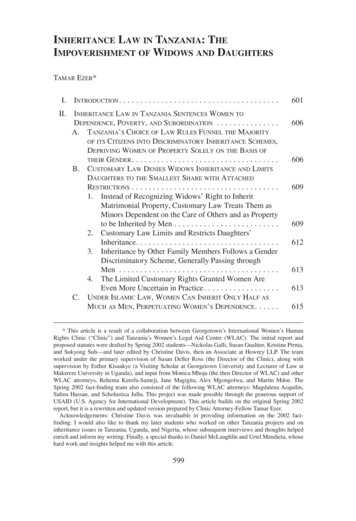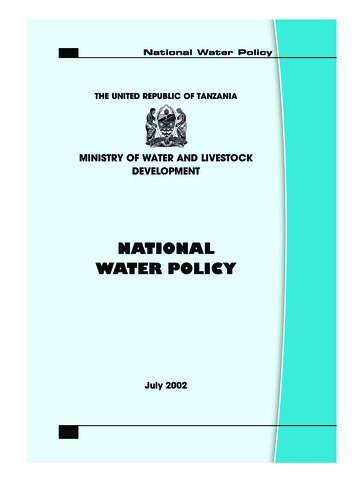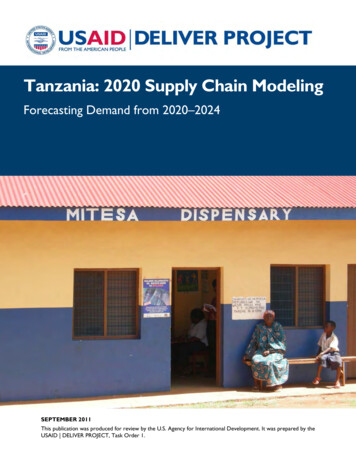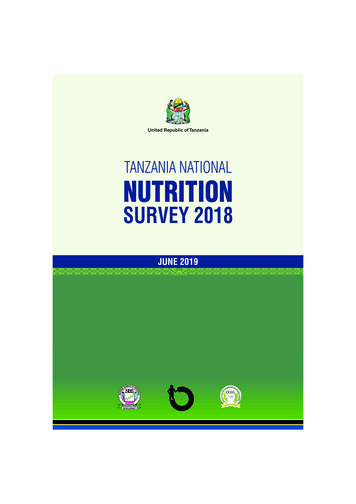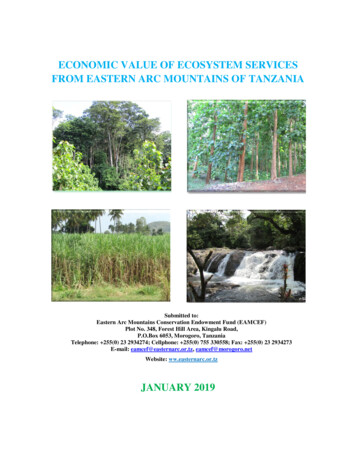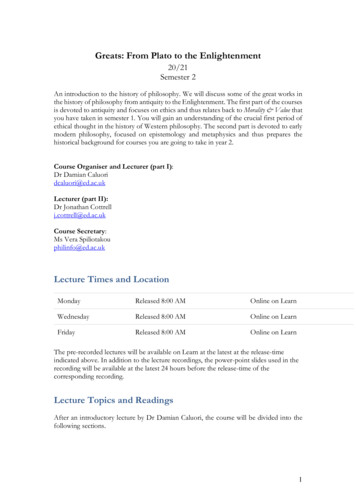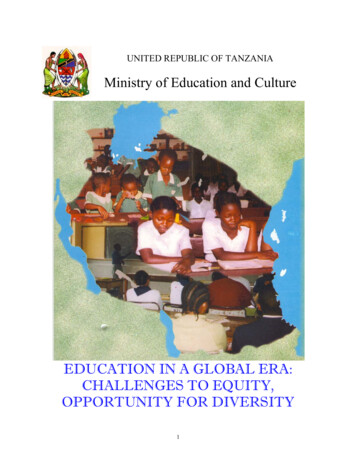
Transcription
UNITED REPUBLIC OF TANZANIAMinistry of Education and CultureEDUCATION IN A GLOBAL ERA:CHALLENGES TO EQUITY,OPPORTUNITY FOR DIVERSITY1
THE UNITED REPUBLIC OF TANZANIAMINISTRY OF EDUCATION AND CULTUREEDUCATION IN A GLOBAL ERA: CHALLENGESTO EQUITY, OPPORTUNITY FOR DIVERSITYPaper presented at the Fourteenth Conference of Commonwealth Education Ministers (14CCEM) Halifax, Nova Scotia, Canada, 27 – 30 November, 20002
TABLE OF CONTENTSLIST OF ABBREVIATIONS .IIIEXECUTIVE SUMMARY . IV1.INTRODUCTION . 11.1 BACKGROUND . 11.2THE MAIN PROVIDERS OF EDUCATION AT DIFFERENT LEVELS. 11.3EDUCATION LEVELS . 21.4HISTORY OF EDUCATION PROVISION . 21.5 THE ECONOMIC, SOCIAL AND POLITICAL CONTEXTS AND THEIR EFFECTS ON THE EDUCATION . 41.6 THE PURPOSE OF EDUCATION IN TANZANIA . 52.1EARLY CHILDHOOD CARE AND DEVELOPMENT . 62.2PRIMARY EDUCATION . 72.3ADULT EDUCATION . 82.3.1Integrated Community Based Adult Education (ICBAE) . 82.3.2Complementary Basic Education in Tanzania (COBET) . 102.4SPECIAL NEEDS EDUCATION IN TANZANIA . 112.5SECONDARY EDUCATION . 142.6 TEACHER TRAINING . 162.7 TECHNICAL AND HIGHER EDUCATION . 162.7.1 Universities and Colleges . 162.7.2Institute of Technology and Technical Colleges. 183.IMPLICATION OF GLOBAL ERA . 193.1 THE CHALLENGES OF EDUCATION IN TANZANIA . 193.1.1The Globalisation Challenges . 203.1.2 Education as a commodity. 233.1.3 The HIV/AIDS challenge . 243.1.4Access and Equity in Education . 273.2 THE TANZANIA RESPONSE TO CHALLENGES . 283.2.1International and Regional Agreements. 283.2.2Formulation of Tanzania Macro Policies . 293.2.3The Reforms . 313.2.4Sub-Sector Plans and Priorities . 333.2.4.1 Plans and Priorities for basic education . 333.2.4.2 Plans and Priorities for Secondary Education . 363.2.4.3 Plans and Priorities for Higher Education. 383.2.4.4 Plan and Priorities for Special Education. 383.2.4.5 Growth in private Institutions and Opportunities. 383.2.4.6 Diversification and broadening of education financing base . 393.2.4.7 Alternative scenarios for Training of Teachers . 393.2.4.8 Establishment of alternative ways of training . 403.2.4.9 Role of news media. 413.2.4.10 Role of Information and Communication Technologies . 413.2.4.11 Safeguarding Culture Integrity . 423.2.4.12 Change in curriculum . 433.2.4.13 Opportunities in respect in respect to improvement of Education Management information System . 433.2.4.14 Opportunities in respect to inadequate co-ordination and management capacity at all levels . 433.2.4.15 New ways of increasing financing base for education sector and governance . 443.2.4.16 Opportunities with regard to improving teaching-learning environment. 443.2.4.17 Opportunities in Addressing HIV/AIDS pandemic . 454.SHARED VALUES . 524.1 TRANSMISSION OF VALUES THROUGH EDUCATION . 534.2 BASIC EDUCATION. 534.3 SECONDARY EDUCATION . 54i
5.FUTURE DIRECTION AND REQUIREMENT. 575.15.25.35.45.55.65.7PRE-PRIMARY SCHOOL. 57ADULT EDUCATION AND NON-FORMAL EDUCATION . 57PRIMARY EDUCATION . 57SECONDARY EDUCATION . 58TEACHER TRAINING . 59TECHNICAL AND HIGHER EDUCATION . 59SPECIAL EDUCATION . 59REFERENCES . 60APPENDIXES . 62Appendix 1 Primary School Examination Results and Ranking of Regions (P.S.L.E), 1999 . 62Appendix 2 Primary Education Leavers and Form One Selection 1963-1999. 63Appendix 3 Female/Male Student Enrolment Proportions at the University of Dar es salaam (1995/96 - 1999/2000 . 63Appendix 4 Female/Male Student Proportion at Muhimbili University College of Health Services (1995/96 1999/2000). 64Appendix 5 Female/Male Proportion at Sokoine University of Agriculture (1996/97 - 1999/2000) . 65Appendix 6 Female/Male Student Proportion at the Open University of Tanzania (1995/96-1999/2000) . 66Appendix 7 Female/Male Student Enrolment Proportions in Technical Colleges (1995/96- 1999/2000) . 67Appendix Female/Male Student Enrolment Proportions in Private Higher . 68learning Institutions (1997/98 - 1999/2000). 68Appendix 9 Sectoral Roles. 69ii
LIST OF ABBREVIATIONSAIDSAcquired Immuno Defficiency SyndromeBEMPCBOBasic Education Master PlanCommunity Based OrganizationCOBETComplementary Basic Education in TanzaniaCSWCommercial Sex WorkersESDPEducation Sector Development ProgrammeGDPGoTGross Domestic ProductGovernment of TanzaniaHEACHigher Education Accreditation CouncilHIVHuman Immuno Deficiency VirusICBAEIntegrated Community Based Adult EducationMISManagement Information ServiceMOECMinistry of Education and CultureMOEZMinistry of Education ZanzibarMSTHEMinistry of Science, Technology and Higher EducationMTPMedium Term PlanNACNational AIDS CommitteeNACPNational AIDS Control ProgrammeNACTENational Council for Technical EducationNECTANational Examinations Council of TanzaniaNGONon-government OrganizationOCPEOther ChangesPersonal EmolumentsPHCCPrimary Health Care CommitteeSTDSexually Transmitted DiseasesTACTechnical AIDs CommitteeTEMPTeacher Education Master PlanUNUnited NationsUNESCOUnited Nations Educational and Scientific OrganizationUPEUniversal Primary Educationiii
WBWorld BankEXECUTIVE SUMMARYECUTIVE SUMMARYThis paper was prepared by the Ministry of Education and Culture for the FourteenthConference of Commonwealth Ministers (14th CCEM) held in Halifax, Nova Scotia,Canada in November 2000. The paper responds to the "Guidelines for Country Papers"issued by the Commonwealth Secretariat (2000).The theme of the paper is Education in a Global Era:Challenges to Equity.Opportunity for Diversity: The purpose of this paper is two-fold. First, it informs andenlightens the rest of the commonwealth about policies, strategies, practices, trends,critical concerns and aspirations of Tanzania in relation to the conference theme.Secondly, the paper provides information on two important areas of concern for theCommonwealth. These are HIV/AIDS which was highlighted as a global emergency byCommonwealth heads of Government at their last summit in South Africa (CHOGM,November 1999), and Shared Values that are supposed to underpin much of what thecommonwealth represents in the modern world.In this paper we review the process of educational development in Tanzania as we enterthe 21st Century. The education sector has gone through a number of changes, sinceindependence. The landmarks which have been instrumental in creating the currentsystem of infrastructure and funding arrangements include the prevailing socio-economiccondition, Tanzania Development Vision 2025 and Poverty reduction strategy 2015aspirations supported by the Education and Training Policy (1995), Technical EducationPolicy (1996) and International and Regional Agreements.The experience of the last decade has underscored the need for better responsive,participatory and accountable systems of educational governance and management. Theeducation for the 21st century need to respond more effectively to changing needs oflearners. Reforms of educational management is urgently needed to move from highlycentralized, standardized and command-driven forms of management to moreiv
decentralized and participatory decision making, implementation and monitoring at lowerlevels of accountability.This paper is divided into six sections. In the first section, we provide a brief overview ofsocial political and economic context of education transformation. The section outlinesproviders of education at different levels and briefly analyses the purpose and changeswhich have shaped the process of provision of education in Tanzania. The economic andsocial challenges facing our nation are characterized most importantly by high levels ofpoverty, high population growth rates, increasing incidences of HIV/AIDS, low level ofliteracy, slow economic growth and poor access and inequities in the provision ofeducation - largely frame the education challenge within Tanzania.The second section provides an analysis of current status and trends in educationsubsectors: Early childhood care and Development, Primary, Adult, Secondary, Special,Teacher training and Technical and Higher education.CURRENT STATUS AND RECENT TRENDSEarly childhood care and DevelopmentPre-school education is a shared responsibility between the Ministry of Labour SocialWelfare and Youth Development and the Ministry of Education and Culture. NGOs,CBOs and the private sector have a substantive contribution in this area especially inurban areas. Although the sub-sector faces several problems, enrolment has steadilyincreased over the years.Primary EducationPrimary education suffered a number of problems in the 1990. These included decliningenrolments, declining quality, declining completion rates and increased drop out rates.However, in recent these problems are being addressed and positive results have alreadybeen registered.TheMOEC has instituted a Community Education fund whichaddresses issues of access, persistence performance, community ownership planning andmanagement of resources. To improve the micro planning at the school and districtlevels the MOEC has established the Whole School Development Programme (WSDP).v
Adult EducationAdult education activities deteriorated in the early 1990s leading to increased illiteracyrates. There have been recent initiatives to revamp adult education through two mainprogrammes, namely the Integrated Community Based Adult Education (ICBAE) andComplementary Basic Education in Tanzania (COBET). The ICBAE integrates literacytraining with self-help income generating projects and credit schemes.Special Needs EducationAlthough special needs education has been provided since the years of Independence,only a small proportion of handicapped children (about 1%) have access to education.Most institutions which provide education services to the handicapped are run by NGOs.At higher learning institutions handicaped students form a very small proportion (about0.5%). Some of these students are learning through the distance mode of education andsome of them are learning through the residential mode.Secondary EducationSecondary education has improved during recent years. Total enrolment, number ofschools survival rate and pass rate at both Form Four and Six have increased in the lastfive years. The inception of ESDP and consequently the preparation of the SecondaryEducation Master Plan aims at improving secondary education. At the secondary level,there is a bursary scheme known as the Girls Secondary Education Support (GSES)targeting academically able girls from poor house holds.Teacher TrainingTeacher training is offered in 35 Government Teacher Training Colleges and in privatelyowned colleges. Enrolment in these colleges and at universities has increased over thepast five years.vi
Technical and Higher EducationHigher EducationHigher Education is provided by both Public and Private Universities and otherinstitutions. At the moment there are 3 Public Universities and 2 constituent colleges.There are 7 private universities and 2 constituent colleges. These institutions areregistered and accredited by the Higher Accreditation Council (HEAC) which wasestablished in 1998.In recent years, the Government of Tanzania (GoT) formulated articulate developmentvision known as “Vision 2025”, which focuses on attaining a high quality livelihood,good governance and the rule of the law, and putting in place a strong and competitiveeconomy.Quality education is of paramount importance as it leads to quality livelihood. Hence toguide provision of Higher Education the Government has issued the Higher EducationPolicy in 1999. As a result of implementation of this policy, enrolment has risen by 28%in 3 years (1997/98 – 1999/2000).The establishment of HEAC has facilitated establishment of nine universities nowoperating, with a total number of 1,168 students.Special efforts are made by the GoT in collaboration will foreign donors to increasefemale enrolment in higher learning institutions with special emphasis on sciencesubjects.There are about 12 other higher education institutions with a total of 4354 enrolmentwhich provide non-university education.Technical EducationTechnical Education is provided to post secondary graduates in Technology Institutes andTechnical Colleges leading to technician and engineering qualifications.viiThe total
enrolment in these institutions is 2049 students of which only 134 are females. TheNational Technical Education Policy issued in 1996 guides the provision of technicaleducation. Quality control of technical education is the responsibility of the NationalCouncil for Technical Education (NACTE) which was established in 1997.The third section outlines and discusses the challenges of education in Tanzania. Thesechallenges have been categorized into mainly five: Globalisation Challenges Improvement of education HIV/AIDS Access and equity in education Inclusive special needs educationWith respect to globalisation challenge it is argued that advances in informationtechnology internationally has necessitated the need to provide distance learning which ismore flexible to suit in the needs of the learners. However, Tanzania make the use ofmodern technology and particularly the use of distance learning difficult except inprivileged urban areas, due to lack of information and communication infrastructure.Related to this challenge, are challenges of providing quality, access and equitableeducation due to having poor teaching learning environment and inadequate capacity toplan and manage education at grass-root levels.A particular challenge facing Tanzania is the need to meet the growth health challenge ofHIV/AIDS pandemic, as it is already decimating population in Tanzania. This alreadyhas had a disproportional negative impact on increased potential for socio-economicdevelopment. With reference to education, the impact will be declining enrolment levels,reduced entrants, higher drop-out rates, increased number of orphans and repeaters rates.HIV/AIDS will also have an impact in exacerbating the problem of shortages of skilledpersonnel and reduced contact time in classrooms, hence, affecting performance .In response to the above mentioned challenges, Tanzania being the signatory of theInternational and regional agreements, sees that these challenges of the 21st centuryviii
present opportunities consistence with our macro and micro-policies, reforms, plans andpriorities within education sub-sectors.In section four, we provide a brief of one of the most daunting challenges as we join the21st Century, which is the complicated area of values in education. In Tanzania valuesare transmitted through both formal and non-formal levels of education through socialstudies and vocational skills (basic education). History, Geography, Physical Education,Home Economics and Social studies (secondary) and development studies plus thoseoutlines in the above mentioned subject's (university level). Inter-disciplinary bodies ofknowledge such as human rights are also taught across the education system. Integrationof values into the curricula has been identified as best means of transmitting thesevalues.In the final section, the reforms in every sub-sector are outlined and discussed. The mainfuture directions include formalization of pre-primary education, improving adulteducation programmes through the expansion of Integrated Community Based AdultEducation (ICBAE) and Complementary Basic Education (COBET) programmes,improvement of the quality of education, provision of equitable education services aswell as broadening of financing base for education. The Policy Framework will bedeveloped to enhance collaboration between ministries, NGOs/CBOs, Civil Society andother education stakeholders. Towards this form of partnership we shall jointly plan,monitor and facilitate aid coordination towards country leadership, ownership andimplementation. Moreover the study is being carried out with the aim of mainstreamingthe ongoing projects/programmes activities into ESDP.In order to increase girls participation, retention performance, persistence and completionof secondary education the policies which are in place will be re-emphasized. Theseinclude: De-boarding Policy of urban Government secondary schools (1995) which didnot affect girls boarding schools. Establishment of girls day streams in the existing boys government schools. A special preferential examination grade for girls at all levels of education.ix
Elimination of gender stereotyping through the curriculum textbooks andclassroom practices. Double shifting in some urban secondary schools with the aim of increasingenrolment. Provision of comprehensive school services covering academic courses, sexand gender education, counseling in relation to the promotion of positive selfimages and role modeling, family planning, prevention of STDs/HIV/AIDS,pregnancy and abortion, post-abortal counseling, income generating activitiesand reproductive health.While cognisant of the need for the Tanzania government to have political commitmentand will to implement these reforms, resources are needed. We would therefore requestall our developing partners to assist in bridging the gap of financing the Education SectorDevelopment Programme.We look forward to this conference as an important forum for sharing experiences andvision, to enable our countries, individually and collectively, to better mediate thetrajectory of globalisation in the future.x
1. INTRODUCTION1.1 BackgroundThe United Republic of Tanzania is a result of union between two independentsovereign states known as Tanganyika and Zanzibar which took place on 16thApril, 1964. Tanzania is situated between 20 and 11.70 South and 29.70 and 400East just south of the equator between the Great Lakes of Victoria, Tanganyikaand Nyasa and the Indian Ocean. It shares common borders with eight countries:Kenya and Uganda to the North; Burundi, Rwanda; Democratic Republic ofCongo to the West and Zambia, Malawi and Mozambique to the South. Tanzaniacovers 945,000 square kilometres, including approximately 60,000 squarekilometres of inland water.The population is about 32 million people with an average annual growth rate of2.8 percent per year.Females comprise 51% of the total population.Themajority of the population resides on the Mainland, while the rest of thepopulation resides in Zanzibar. The life expectancy is 50 years and the mortalityrate is 8.8%. In addition, it has a refugee population of over 800,000.The economy of the United Republic of Tanzania depends upon Agriculture,Tourism, Manufacturing, Mining and Fishing. Agriculture contributes about 50%of GDP and accounting for about two-thirds of Tanzania’s exports. Tourismcontributes 15.8%; and manufacturing, 8.1% and mining, 1.7%.The school system is a 2-7-4-2-3 consisting of pre-primary, primary school,ordinary level secondary education, Advanced level secondary, Technical andHigher Education. Primary School Education is compulsory whereby parents aresupposed to take their children to school for enrollment.1.2The main providers of education at different levelsEducation and Training in Tanzania is undertaken by several Ministries, NGOs,communities and individuals. The ministries responsible include that of1
Education and Culture, Regional Administration and Local Government, Science,Technology and Higher Education and the Ministry of Education, Zanzibar.The establishment, management and administration of primary schools is theresponsibility of the Ministry of Regional Administration and Local Governmentand the Ministry of Education Zanzibar.Secondary schools and Teachers colleges operate under the Ministry of Educationand Culture and the Ministry of Education Zanzibar while public universities,Institute of Technology and Technical Colleges operate under the Ministry ofScience, Technology and Higher Education.1.3Education levelsEducation and Training provision in Tanzania has three levels: These are Basic Education consisting of 2 years Pre – Primary Education and 7 yearsPrimary Education.The pupil goes to a secondary education level afterpassing the Primary School Leaving Examination (PSLE). Secondary Education has two stages Ordinary level - form I up to From IV (4years). Advanced level Form V up to Form VI (2 years) A NationalExamination is administed at the end of each level. Technical and Higher Education Level consists of 3 years leading to variousoccupations1.4History of Education ProvisionThe Education sector has gone through a number of changes since independence.These changes have shaped the process of provision of education in Tanzania.The consequent landmarks have been instrumental in creating the current systemof infrastructure and funding arrangements.The prevailing socio-economicconditions and the Tanzania Development Vision 2025 aspirations supported bythe 1995 Education and Training Policy call for fundamental transformations andremedy of inherent deficiencies in the education delivery system.2
The following landmarks have prepared the environment for the envisagedreform: In 1963 the government abolished all forms of discrimination on racial andreligious basis in education at all levels as a result of the Education Act of1962. Privately owned primary schools were nationalized and educationbecame free at all levels.Furthermore, the Government streamlined theschool curriculum and made Kiswahili the National language. In 1967 Education for Self-Reliance (ESR) philosophy was adopted to guidethe planning and practice of education.ESR was sequel of the ArushaDeclaration; it appraised the education system existing then and proposedfundamental reforms in the school curriculum. Between 1967 and 1978 the government took several steps and enacted lawsto legalize the Arusha Declaration and ESR directives as outlined hereunder:-The philosophy called for curriculum reform in order to integrate theorywith acquisition of practical life skills. It also linked education plans andpractices with national socio-economic development and the world ofwork.-In 1970 privately owned secondary schools were nationalized with anintention of expanding school enrolment in order to enhance access.-In 1971 the first Tanzanian public examinations were administered.-In 1972 the government diversified secondary education into vocationalbiases (commercial, agriculture, technical and home economics), while atthe same time established post-primary vocational centres to be attached toeach primary school.-In 1973 the National Examination Council of Tanzania (NECTA) wasestablished.3
-In 1974 the Musoma Resolution on Universal Primary Education (UPE)was announced. In 1975 the Tanzania Institute of Education (TIE) was establishedIn 1978 the National Education Act No. 25 was passed by Parliament, toconsolidate education at all levels. The Act re-introduced the inspectoratewhich spelt out the role of the Central Government and that of the LocalGovernment in education provision and laid out conditions and procedures forthe registration of private schools and for licencing as well as the registrationof teachers. In 1981 the Presidential Commission of Education was appointed to reviewthe existing system of education and proposed necessary actions to lead thecountry towards the year 2000. In 1989 the Teachers Service Commission (TSC) was established The National Education Act No. 25 of 1978 was amended in 1995 to facilitatethe establishment of the Higher Education Accreditation Council which wasofficially inaugurated on the 3rd Janurary, 1997.1.5The Economic, Social and Political Contexts and their Effects on theEducationEducation is circumscribed by various contexts such as social, economic, politicaland technological environment. There is no doubt over the world today thateducation is a key input for economic growth, political and cultural growth ofnations.Politically, Tanzania which oper
Appendix 4 Female/Male Student Proportion at Muhimbili University College of Health Services (1995/96 - . UPE Universal Primary Education . iv WB World Bank . schools survival rate and pass rate at both Form Four and Six have increased in the last
